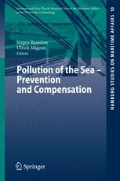Abstract
Persistent toxic substances (PTS) are organic chemicals that are environmentally persistent and harmful to human health and to the environment. Bioaccumulation or increase in concentration of a pollutant from the environment to the first organism in a food chain refers to how pollutants enter a food chain. They can be released into the environment in various ways including during their production, application (e.g., pesticides), or combustion (e.g., dioxins). Whether produced by natural or anthropogenic processes, PTS have a particular combination of physical and chemical properties allowing them to remain intact for exceptionally long periods after release into the environment. PTS migrate between different environmental compartments and undergo long-range transport (LRT) by natural processes in both the atmosphere and oceans, thus becoming ubiquitous global contaminants. PTS are distributed throughout the oceans as a consequence of atmospheric deposition and direct introduction into aquatic systems. Scientific and political interest in the fate and behaviour of PTS in the environment arises from concern over human exposure to these chemicals and their discovery in pristine environments far from source regions. There is international interest in reducing and (possibly) eliminating releases of PTS, and in reducing risks to regional and global environments. International agreements, such as the UNEP Stockholm Convention on Persistent Organic Pollutants, the UNECE Convention on Longrange Transboundary Air Pollution, and the OSPAR Convention, require assessment criteria of the environmental risks posed by PTS based on sound scientific knowledge and models.
Access this chapter
Tax calculation will be finalised at checkout
Purchases are for personal use only
Preview
Unable to display preview. Download preview PDF.
References
Lammel, G., Feichter, J., Leip, A.: Long-range transport and global distribution of semivolatile organic compounds: A case study on two modern agrochemicals. Report of the Max Planck Institute for Meteorology, No. 324, Hamburg, 44 pp, 2001.
Pohlmann, T.: Predicting the thermocline in a circulation model of the North Sea. Part I: Model description, calibration, and verification. Continental Shelf Research, 7, 131–146, 1996.
Sündermann, J., (ed.): Circulation and contaminant fluxes in the North Sea. Berlin, Heidelberg, New York: Springer, 654 pp, 1994.
Editor information
Editors and Affiliations
Rights and permissions
Copyright information
© 2007 Springer-Verlag Berlin Heidelberg
About this paper
Cite this paper
Ilyina, T. (2007). Modelling the Fate of Persistent Toxic Substances in the North Sea: γ-HCH and PCB 153 Multiyear Simulations. In: Basedow, J., Magnus, U. (eds) Pollution of the Sea — Prevention and Compensation. Hamburg Studies on Maritime Affairs, vol 10. Springer, Berlin, Heidelberg. https://doi.org/10.1007/978-3-540-73396-6_3
Download citation
DOI: https://doi.org/10.1007/978-3-540-73396-6_3
Publisher Name: Springer, Berlin, Heidelberg
Print ISBN: 978-3-540-73395-9
Online ISBN: 978-3-540-73396-6
eBook Packages: Earth and Environmental ScienceEarth and Environmental Science (R0)

